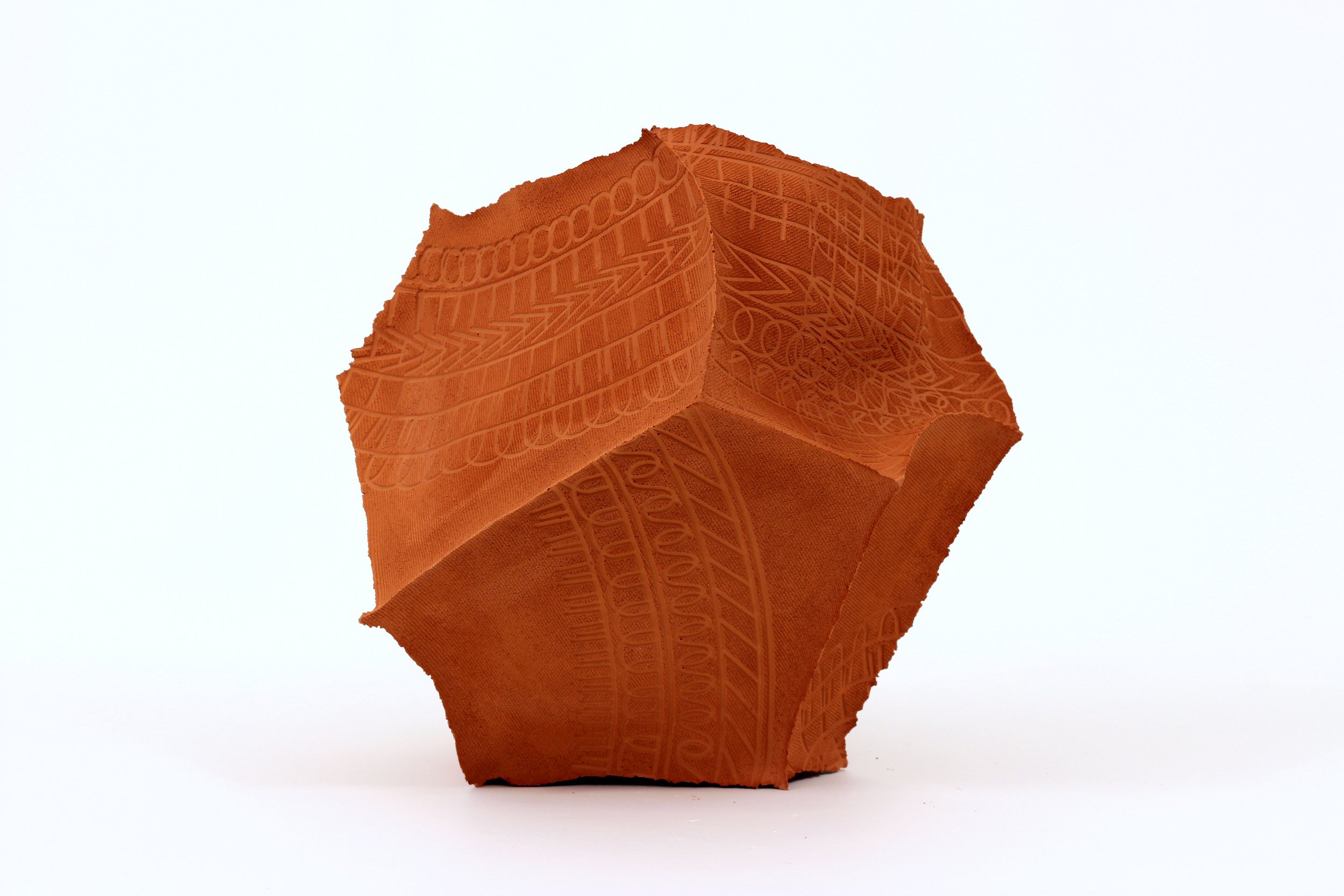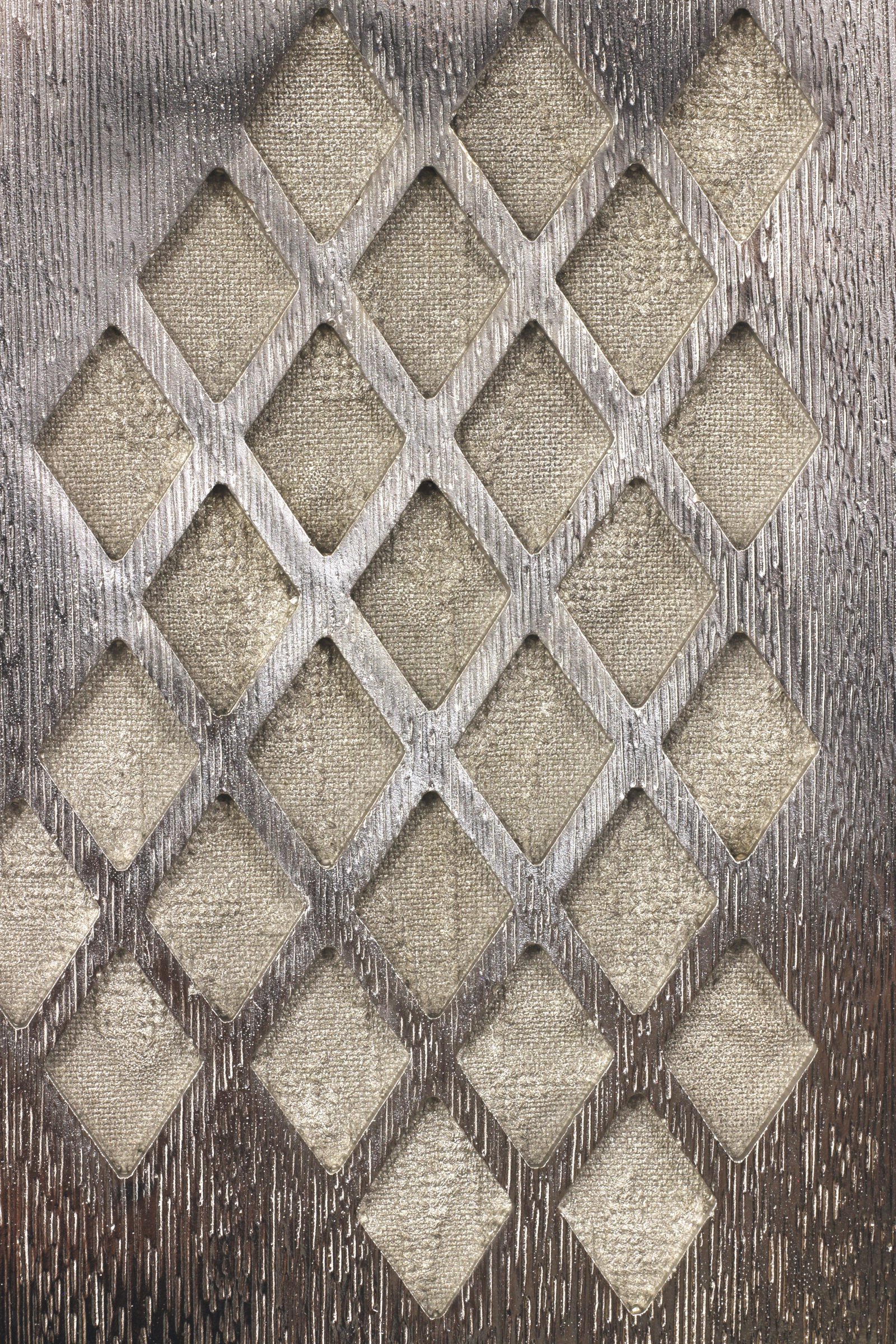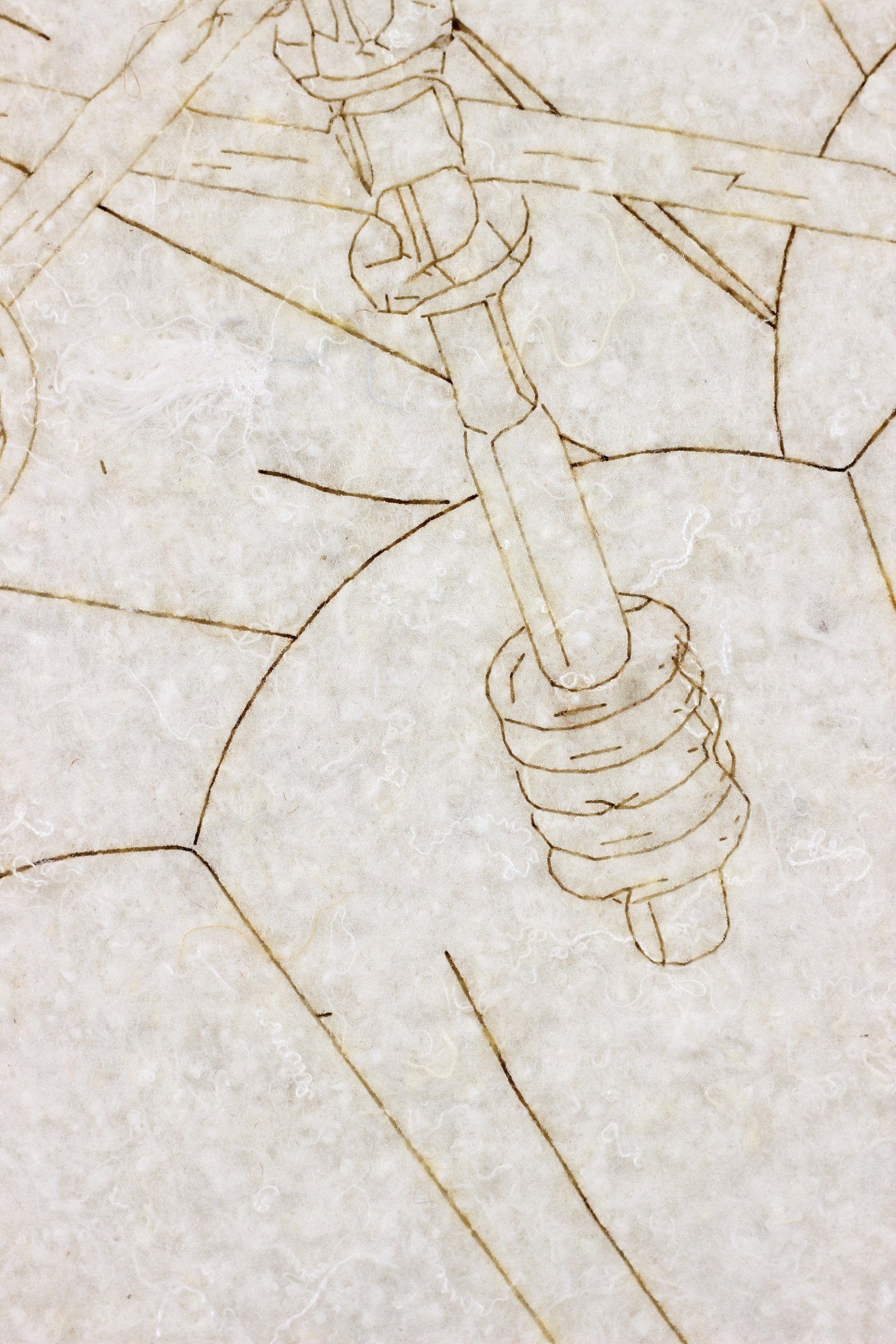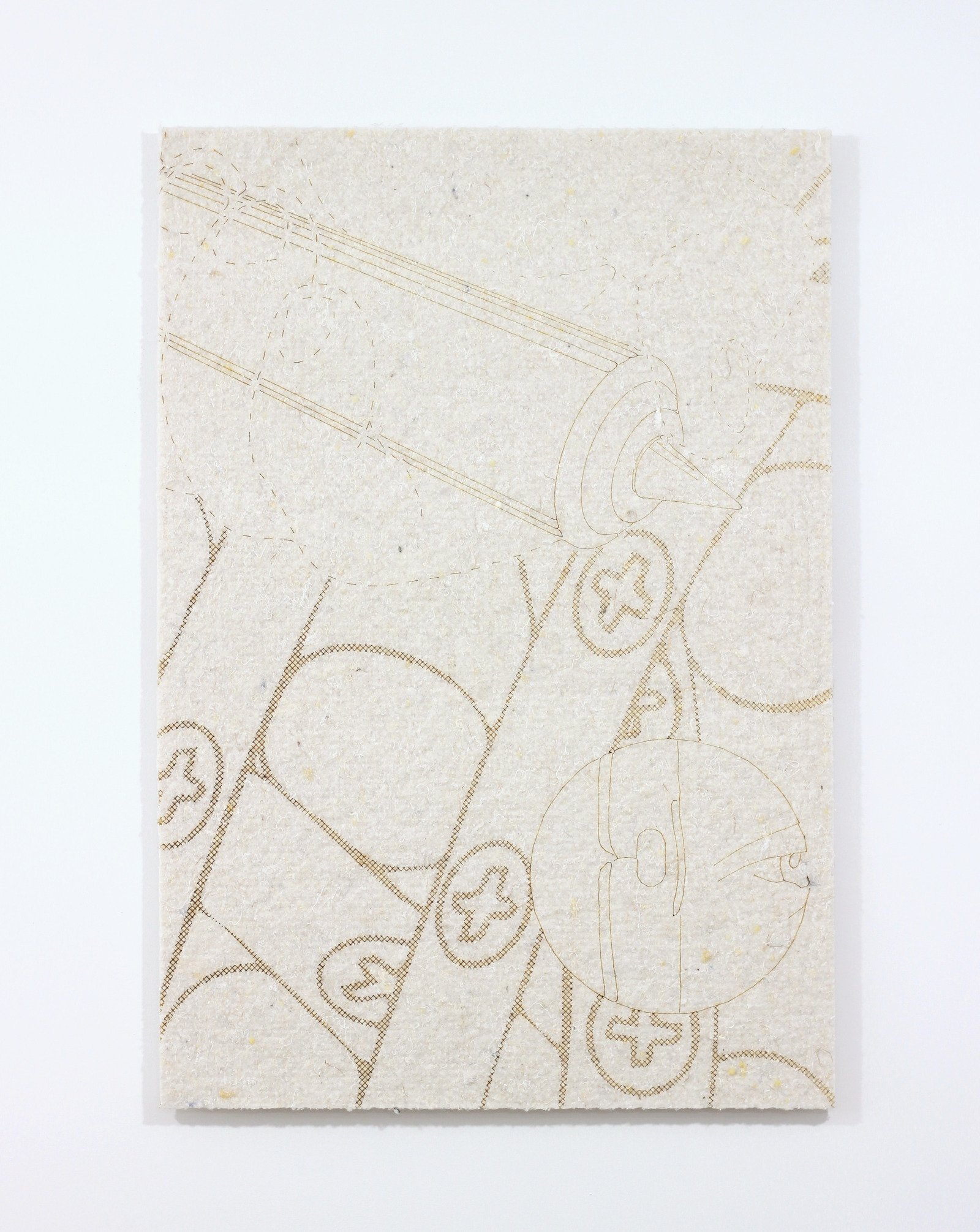James Fuller
Sealed from the Inside
Art-O-Rama, Marseille (25 - 28 August 2022)
James Fuller’s practice, possessing a rich material palette, deals in the currency of real world surfaces. Situated between craft objects and digitally manufactured goods, his studio is a place where discarded and wasted energies come to thrive. The work incorporates ideas of ritual and labour, where details dissolve, melt or transform into new surfaces constantly slipping between malleability and fixed states.
The rotationally moulded sculptures have an intense physicality - equal measures of eloquence and attitude, underlined by industrial finesse. There is no orientational hierarchy to these volumes, no top or bottom, or predetermined angle of display; they encourage three hundred and sixty degree viewing. Like a tailor, Fuller maps lines and patterns for stitching, combining silicone skins of denim towards a non human, hybrid end product, rather than one suited to limbs. The denim surface acts as a neutral plane for the text to score and etch, the material itself already well loaded with socio-economic connotations.
Text has formed the raw material for many prominent artists across the last century to challenge ideas of power, identity or sexuality. Here, Fuller harnesses text in a different way without losing the potency of the message. The texts encompass the choreography of production: the text spills and collides, flows over the surface as the gypsum changes from a liquid to a solid state. The tension is held - at times fervent and indistinguishable - words ebb and flow across the surface as the shards jag and collide. The ‘A’ of ‘A softening grip’ and ‘A difficult embrace’ suggest routes for the eye to scan but sometimes lead to dead ends, a deception of indecipherable disorder.
Recurring materials which form part of Fuller’s studio practice also find their way into artworks and become embedded. The use of clay enables Fuller to plug holes and seal gaps, taking advantage of its elastic properties. With Innie and Outtie, clay is the original material. How does one classify these sculptures? Something more than just unique? The human fingerprint is one of the most distinctive identifiers on earth; something always left behind on surfaces. The patterns, bumps and ridges are visible in a foetus at twenty-four weeks; an appropriate reference that the umbilicus provides, the essential source of oxygen and nutrition, which after birth has no function. These sculptures compliment each other, without one, there cannot be another. Yet like siblings they are separate and independent. The notion of connectivity is suggested as fingertips are used in place of computer passwords, and are essential for digital scrolling. Everything is now at the flick of a (clean) fingertip.
The five lightly scored fabric panels represent roads not taken. Taken from an institutional repository of abandoned patents, the imagery serves as an index of relinquished hopes and ideas. Such designs were intended to capture an audience, served a need or dominated a market. Fuller has extracted these digital drawings from the protection of private interest. Patents which were intended to protect property, where individual or corporate interest is asserted over collective intelligence and innovation, can now can be found - available to all, one just needs to know where to look. Unprotected, they await potential resurrection, consolidation, assimilation by others.
There is an archaic simplicity to the human endeavour of constantly improving and protecting a vision of an axe (Easy Call Abandon (axe hatch), a slingshot (East Call Abandon (pride) or a survival bracelet (Easy Call Abandon (anti-gravity). Unified by notions of survival, there is a primeval essence to these objects, but they are contemporary, most designed very recently. Fuller strips, adds or overlaps these graphics. The result is a harmony of line and genealogically reference Robert Morris’s 1970’s drawings, In the Realm of the Carceral.
There is an economy and succinctness, as if an entrepreneur, under the scrutiny of possible investment, has condensed an idea into one clear sentence. These cropped compositions and crisp contours are more like renaissance drawings than bureaucratic intellectual property. The use of a textile composite as ‘canvas’ commonly found in spring mattresses, leads to an inherent relationship with the body for which the mattress provides support. Much like the suite of works presented here, the body is always implied; it is everywhere and nowhere. There is a contrast - the relationship with the artists hand has changed. The ‘workflow’ remains digital, unlike the other sculptures and electroplated panels which slip and slid between silicones, waxes, gypsums and metals with multiple intermediary or intersecting stages. Though guided by their content, these have a much lighter manipulation of selection.
While both alchemical and metallurgical, the electroplated panels retain a strained relationship with the physical world. The metal particles have been grown on silicone moulds with an electric current in an acidic copper solution. These metal accretions make us question the strength and solidness of the artwork. They are strong lightweight objects; the metal surfaces are fresh, raw, in their emerging state. They have not been manipulated or pressed. At the same time, and paradoxically, they appear like fossils, ever evolving. A collage of interlocking surfaces, built from the back of a faux wooden drinks tray, using existing stitched fabric images of flowers, that are cropped and obstructed by the grill formation (Adjusted plates (bloom #1). Adjusted plates (earthing point) contains the interlocked sole of a foot with the padded surface of a synthetic fabric used for winter jackets or sleeping bags.
Together these artworks emerge in clusters, from a patchwork of sources. Denim, spring mattress texture, found patents, winter jackets or fingertips, all exceed their real worldliness. They are sucked into Fuller’s orbit of production to form hollows, plates and scored skins. Whilst decontextualised or repurposed, these objects of contradictory emotions become chimeric, whilst still retaining their original DNA.
James Fuller (b. 1988) lives and works between London and Athens, Greece and graduated from the Royal College of Art (London) in 2018. Recent solo exhibitions include Perfect Living (South Parade, London, 2021). Recent group exhibitions include Contemporary Sculpture Fulmer (Slough, 2022), Under the Volcano (Brooke Benington, Mexico City, 2020), An Arrangement in Two Halves, a Bench in Two Parts, with Marco Miehling, (William Benington Gallery, London, 2019) and Further Images, (White Crypt, London, 2018). He was the recipient of the Kenneth Armitage Post-graduate Sculpture Prize and the Tiffany's x Outset studiomakers award (both 2018) and was awarded a Develop Your Creative practice grant from Arts Council England in 2020. He also featured in Perpetual Inventory Vol.3 by Offline Press, an independent publication focused on process in sculptural practice.
A difficult embrace, 2022. Polymer modified gypsum, oxide pigments, 23(H) x 22 (W) x 22 (D) cm
A softening grip, 2022. Polymer modified gypsum, oxide pigments, 40(H) x 36 (W) x 25 (D) cm
(Alternative view) A softening grip, 2022.
(Detail) A softening grip, 2022.
Left: Innie, 2022. Polymer modified cement composite, 22 (H) x 23 (W) x 23 (D) cm
Right: Outtie, 2022. Polymer modified cement composite, 22 (H) x 23 (W) x 23 (D) cm
(Detail) Innie, 2022.
Innie, 2022. Polymer modified cement composite, 22 (H) x 23 (W) x 23 (D) cm
Sealed from the inside, 2022. Polymer modified gypsum, oxide pigments. 26(H) x 32 (W) x 29 (D) cm
(Detail) Sealed from the inside, 2022.
(Alternative view) Sealed from the inside, 2022.
Adjusted plates (bloom #1), 2022. Nickel plated copper, Aluminium and stainless steel fixings, 34 (H) x 20 (W) x 2.5 (D) cm
(Detail) Adjusted plates (bloom #1), 2022. Nickel plated copper, Aluminium and stainless steel fixings, 34 (H) x 20 (W) x 2.5 (D) cm
Adjusted plates (earthing point), 2022. Nickel plated copper, Aluminium and stainless steel fixings. 34 (H) x 20 (W) x 2.5 (D) cm
(Detail) Adjusted plates (earthing point), 2022. Nickel plated copper, Aluminium and stainless steel fixings. 34 (H) x 20 (W) x 2.5 (D) cm
Adjusted plates (bloom #2), 2022. Nickel plated copper, Aluminium and stainless steel fixings. 34 (H) x 20 (W) x 2.5 (D) cm
(Detail) Adjusted plates (bloom #2), 2022. Nickel plated copper, Aluminium and stainless steel fixings. 34 (H) x 20 (W) x 2.5 (D) cm
Easy Call Abandon (anti-gravity), 2022. Mixed textile mattress wadding, powder coated steel, 91(H) x 63 (W) x 3 (D) cm
(Detail) Easy Call Abandon (anti-gravity), 2022.
Easy Call Abandon (axe hatch), 2022. Mixed textile mattress wadding, powder coated steel, 91(H) x 63 (W) x 3 (D) cm
(Detail) Easy Call Abandon (axe hatch), 2022.
Easy Call Abandon (buckling slogans), 2022. Mixed textile mattress wadding, powder coated steel, 91(H) x 63 (W) x 3 (D) cm
(Detail) Easy Call Abandon (buckling slogans), 2022.
Easy Call Abandon (pride), 2022. Mixed textile mattress wadding, powder coated steel, 91(H) x 63 (W) x 3 (D) cm
(Detail) Easy Call Abandon (pride), 2022.
Easy Call Abandon (thumb trigger) 2022. Mixed textile mattress wadding, powder coated steel, 91(H) x 63 (W) x 3 (D) cm
(Detail) Easy Call Abandon (thumb trigger) 2022.
Installation views by Margot Montigny
Work views courtesy of South Parade and The Artist






























